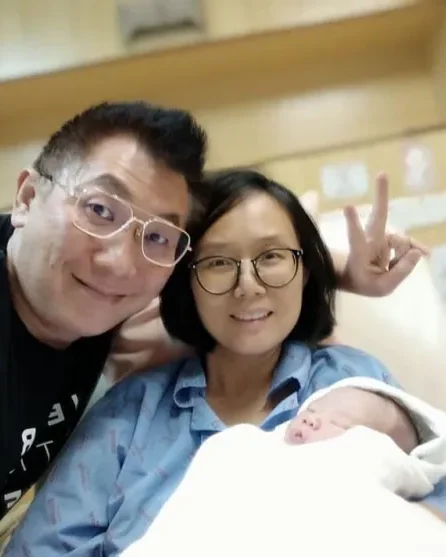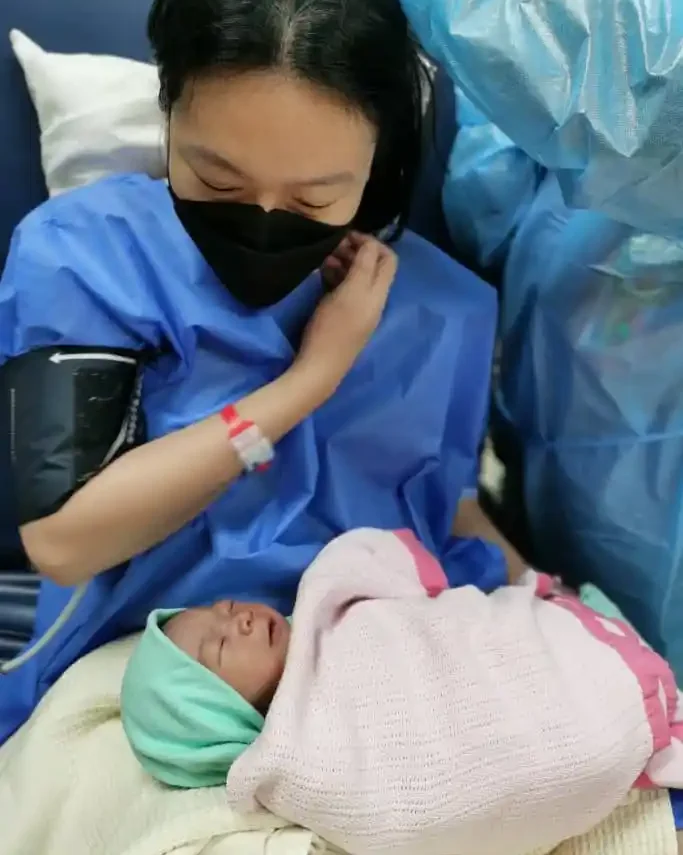√ Natural childbirth
√ No episiotomy
√ No medication
For my first pregnancy, I had heard of HypnoBirthing but didn’t explore it thoroughly. As a result, I went into labor somewhat unprepared. Although I aimed for a natural delivery and avoided an epidural, I still ended up with a local anesthesia injection, an episiotomy, and unfortunately, experienced an infection and postpartum hemorrhage on the sixth day.
For my second pregnancy, at 33 weeks, I accidentally discovered Au Yong San San’s HypnoBirthing workshop. I decided to attend the class and commit to this approach for my delivery.
Just like with my first baby, at 33 weeks, the baby’s head hadn’t descended yet. Initially, I planned to let the doctor assist if the head didn’t turn (as with my first pregnancy). However, after attending the class, San San taught me how to communicate with the baby, practice birth visualization, and use positions like the all-fours/polar bear position. As a result, the baby’s head descended by the 36th week.
During the 37-week check-up, the doctor said I was 3 cm dilated. At 38 weeks, I began to show signs of labor, but since I still had many things to finish, including work, I communicated with the baby, asking her to wait until I was ready.
However, by the end of the 38th week, when I was prepared, the baby suddenly stopped moving. The doctor mentioned that if there was no movement by two days before the due date, we might need to consider induction. Not wanting to induce, I continued to talk to the baby, telling her it was time to meet her parents. I also used natural induction techniques to help the baby come out.
Finally, on July 4th, contractions started at 4 a.m. Initially, I wasn’t sure if they were contractions and thought it was just stomach cramps, so I went to the bathroom. As the contractions became more frequent, I realized the baby was signaling. I started packing my things and woke my husband at 7 a.m. After settling our first child at my sister-in-law’s house, we headed to the hospital for a check-up.
I went to the hospital early to confirm if it was labor and to do a COVID test to avoid missing the opportunity for skin-to-skin contact if the result came too late.
At 9 a.m., after the check-up, I was 5 cm dilated and experiencing mild contractions. I didn’t want to stay in the delivery room to avoid excessive interventions, so after doing the COVID test, I returned home to wait. Although the midwife was hesitant to let me go, concerned that I might deliver quickly as a second-time mom, the doctor eventually approved it, instructing me to come back immediately if contractions became intense or occurred every five minutes.
At 10 a.m., after the COVID test, I bought some food and returned home to eat and relax. I felt more calm this time, as I understood the entire process and my birth plan after the class.
By 1 p.m., the hospital called to confirm that my COVID test was clear. I had eaten and showered and planned to rest while waiting for the baby. Contractions were still mild every half hour, so there were no major issues.
By 2 p.m., there was still no movement, so I continued to rest, listen to rainbow relaxation, and even fell asleep.
By 3 p.m., with no baby movement, I started talking to the baby, urging her to come out today. My husband encouraged me to walk around, so I began doing the prenatal dance I had practiced daily, hoping to wake the baby. The contractions started to pick up but were still mild.
By 4:30 p.m., contractions intensified and came every 15 minutes.
By 4:45 p.m., contractions were every 5-6 minutes. I began using breathing techniques, which made the pain feel much more manageable compared to my first birth.
At 5 p.m., after confirming the 5-1-1 pattern, I prepared to go to the hospital.
By 6 p.m., I arrived at the hospital. I brought only a laptop and a birth ball, and started listening to birth affirmations.
By 6:30 p.m., contractions became stronger, and the doctor suggested breaking my water if dilation hadn’t reached 7-8 cm by then. I was reluctant, so the doctor performed an internal examination and found I was already 8-9 cm dilated.
The doctor said that if my water hadn’t broken or I hadn’t delivered by 8:30 p.m., we might need to consider interventions. I agreed to wait and communicated with the baby, telling her we needed to complete the delivery before 8:30 p.m. to ensure a natural and gentle birth.
By 7 p.m., contractions were stronger and more frequent. I reminded myself to stay calm, using calm breathing and surge breathing techniques, which alleviated much of my discomfort and pain. My husband was very supportive, sitting behind me, letting me lean on him, and providing encouragement, massages, and water.
I lost track of time, but when I felt I couldn’t endure anymore, I called the midwife to check if I was fully dilated and ready to push.
The midwife checked and confirmed full dilation. When I felt the urge to push, I began using J breathing, a technique I practiced during bowel movements. The doctor told me to use my preferred method, even though they were unfamiliar with assisting in a HypnoBirthing delivery.
It was amusing as the doctor, midwife, and nurses watched from the bedside, unsure how to assist with HypnoBirthing. With my husband’s continuous encouragement, I used J breathing to help the baby come out. Although it was painful, I felt more confident knowing the baby would come out soon.
Even though I wasn’t sure if my J breathing was perfect, I encouraged myself, feeling the baby moving closer. The doctor confirmed I was doing it right and told me to keep pushing. Initially, I felt a liquid release and wondered if I had soiled myself.
Quickly, I felt the baby’s head emerging, followed by the body and legs. The amniotic sac burst with a pop, and my husband remarked that the doctor barely avoided getting splashed.
Soon, the baby cried loudly, arriving before 8:30 p.m.! The doctor immediately handed her to me for skin-to-skin contact, which I didn’t get to do with my first baby. This time, my husband also had the chance to cut the umbilical cord. Although the cord delay was brief, around 60 seconds, HypnoBirthing allowed us to discuss and negotiate our birth preferences with the doctor rather than being caught off guard.
Even the doctor, who initially wasn’t very supportive of HypnoBirthing, later told my husband that she admired my determination and ability to use HypnoBirthing for the delivery.
So, I gave birth. While the process wasn’t completely painless, especially when the baby was coming out, the breathing techniques were immensely helpful in reducing pain. This time, I did not need an episiotomy, only a first-degree tear, so recovery was quick and without discomfort.
HypnoBirthing made the process clear, confident, and aligned with what I wanted. I’m very grateful for being introduced to HypnoBirthing in the last two months of pregnancy and for the guidance and encouragement from instructor Au Yong San San, which helped me achieve a gentle and successful delivery. Thank you! 🙏🏻❤️
———————————————-
【Mentor’s Note】
Before the class, Charlize and I reviewed her previous delivery experience. I encouraged her to let go of the past and look forward to a better experience this time.
During the course, she prepared diligently and frequently discussed her concerns with me. Through our interactions, I saw that she had a very specific plan for her upcoming delivery.
Her cervix was 3 cm dilated at 37 weeks, and she understood she wasn’t in active labor yet. She balanced her daily tasks with patiently communicating with her baby, waiting for the right moment.
Finally, she welcomed her baby.
“It wasn’t easy, but I did it,” she told me.
I recall her shedding tears of happiness during the fourth class’s relaxation exercise, envisioning a beautiful delivery. Seeing her state after giving birth, I know she truly embraced a wonderful birthing experience.
I’m genuinely happy for her.





